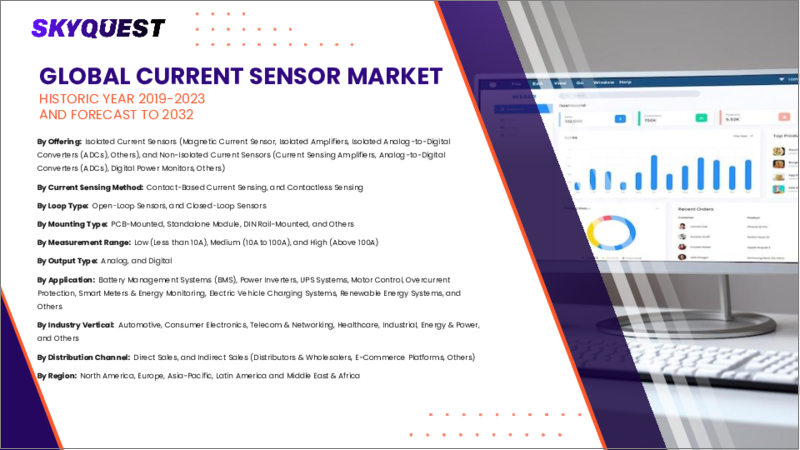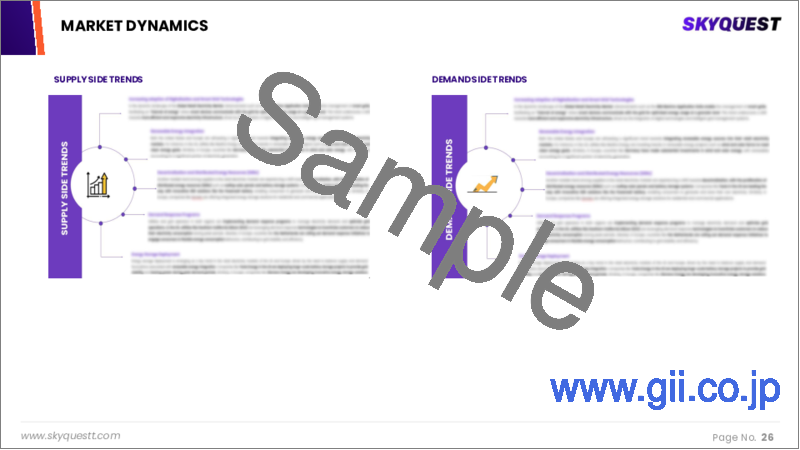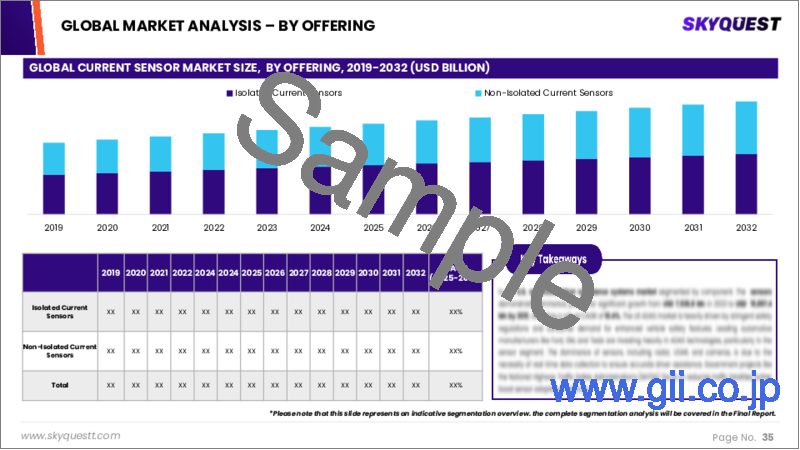|
|
市場調査レポート
商品コード
1707946
電流センサーの市場規模、シェア、成長分析、技術別、センシングタイプ別、出力タイプ別、電流範囲別、取り付けタイプ別、地域別 - 産業予測 2025~2032年Current Sensor Market Size, Share, and Growth Analysis, By Technology (Hall Effect Current Sensors, Current Transformers ), By Sensing Type, By Output Type, By Current Range, By Mounting Type, By Region - Industry Forecast 2025-2032 |
||||||
|
|||||||
| 電流センサーの市場規模、シェア、成長分析、技術別、センシングタイプ別、出力タイプ別、電流範囲別、取り付けタイプ別、地域別 - 産業予測 2025~2032年 |
|
出版日: 2025年04月09日
発行: SkyQuest
ページ情報: 英文 157 Pages
納期: 3~5営業日
|
全表示
- 概要
- 目次
電流センサーの市場規模は2023年に32億4,000万米ドルで、予測期間(2025-2032年)のCAGRは10.1%で、2024年の35億7,000万米ドルから2032年には77億米ドルまで成長する見通しです。
電気自動車とハイブリッド車市場は、EVシステム内の電気の流れを管理するのに不可欠な高度なセンサーに対する需要の高まりによって著しい成長を遂げています。これらのセンサーは、効率的な電力供給の確保、バッテリー機能の監視、エネルギー効率の向上、潜在的な問題の早期発見による安全性の向上に重要な役割を果たしています。排出量削減を求める世界の規制動向は、環境に優しいソリューションに向けたこの動向をさらに後押ししています。Infineon Technologies AGとSvobodaの注目すべきコラボレーションは、Infineonの優れた集積回路とSvobodaの専門知識を活用し、この分野に合わせた先進的な電流センサーモジュールの革新を目指しています。さらに、産業用および自動車用アプリケーションにおいて、費用対効果が高く、コンパクトなセンサーへの需要が高まっており、雷保護などの高度な機能を組み込んだ革新的な設計と新しい製造プロセスが促進されています。
目次
イントロダクション
- 調査の目的
- 調査範囲
- 定義
調査手法
- 情報調達
- 二次と一次データの方法
- 市場規模予測
- 市場の前提条件と制限
エグゼクティブサマリー
- 世界市場の見通し
- 供給と需要の動向分析
- セグメント別機会分析
市場力学と見通し
- 市場概要
- 市場規模
- 市場力学
- 促進要因と機会
- 抑制要因と課題
- ポーターの分析
主な市場の考察
- 重要成功要因
- 競合の程度
- 主な投資機会
- 市場エコシステム
- 市場の魅力指数(2024年)
- PESTEL分析
- マクロ経済指標
- バリューチェーン分析
- 価格分析
- ケーススタディ
- 技術の進歩
- 規制情勢
電流センサー市場規模:技術別& CAGR(2025-2032)
- 市場概要
- ホール効果電流センサー
- オープンループ
- クローズループ
- 変流器(CT)
- フラックスゲートセンサー
- ロゴウスキーコイル
- 磁気抵抗センサー
- 光ファイバー電流センサー
- その他
電流センサー市場規模:センシングタイプ別& CAGR(2025-2032)
- 市場概要
- AC電流検出
- DC電流検出
- AC/DC複合センシング
電流センサー市場規模:出力タイプ別& CAGR(2025-2032)
- 市場概要
- アナログ出力
- デジタル出力
- PWM(パルス幅変調)出力
- 電流出力
- 電圧出力
電流センサー市場規模:電流範囲別& CAGR(2025-2032)
- 市場概要
- 1A未満
- 1A~50A
- 50A~200A
- 200A
電流センサー市場規模:取り付けタイプ別& CAGR(2025-2032)
- 市場概要
- スルーホール
- 表面実装
- パネルマウント
- DINレールマウント
- PCB実装
- バスバーマウント
電流センサー市場規模:感知機構別& CAGR(2025-2032)
- 市場概要
- 接触型(直接)
- 非接触型(絶縁型・間接型)
電流センサー市場規模:最終用途産業別& CAGR(2025-2032)
- 市場概要
- 自動車
- 家電
- 産業オートメーション
- 発電・配電
- 再生可能エネルギー
- 通信
- その他
電流センサー市場規模:地域別& CAGR(2025-2032)
- 北米
- 米国
- カナダ
- 欧州
- ドイツ
- スペイン
- フランス
- 英国
- イタリア
- その他欧州地域
- アジア太平洋地域
- 中国
- インド
- 日本
- 韓国
- その他アジア太平洋地域
- ラテンアメリカ
- ブラジル
- その他ラテンアメリカ地域
- 中東・アフリカ
- GCC諸国
- 南アフリカ
- その他中東・アフリカ
競合情報
- 上位5社の比較
- 主要企業の市場ポジショニング(2024年)
- 主な市場企業が採用した戦略
- 最近の市場動向
- 企業の市場シェア分析(2024年)
- 主要企業の企業プロファイル
- 企業の詳細
- 製品ポートフォリオ分析
- 企業のセグメント別シェア分析
- 収益の前年比比較(2022-2024年)
主要企業プロファイル
- Honeywell International Inc.(USA)
- Allegro Microsystems(USA)
- TDK Corporation(Japan)
- Infineon Technologies AG(Germany)
- Texas Instruments Incorporated(USA)
- Melexis NV(Belgium)
- Analog Devices, Inc.(USA)
- STMicroelectronics N.V.(Switzerland)
- Sensitec GmbH(Germany)
- LEM International SA(Switzerland)
- Tamura Corporation(Japan)
- Asahi Kasei Microdevices Corporation(Japan)
- Pulse Electronics Corporation(USA)
- ACEINNA(USA)
- Murata Manufacturing Co., Ltd.(Japan)
- NXP Semiconductors N.V.(Netherlands)
- Rohm Semiconductor(Japan)
- TE Connectivity Ltd.(Switzerland)
- Eaton Corporation(Ireland)
- Yokogawa Electric Corporation(Japan)
結論と提言
Current Sensor Market size was valued at USD 3.24 billion in 2023 and is poised to grow from USD 3.57 billion in 2024 to USD 7.7 billion by 2032, growing at a CAGR of 10.1% during the forecast period (2025-2032).
The market for electric and hybrid vehicles is witnessing significant growth driven by a rising demand for advanced sensors, which are critical for managing electricity flow within EV systems. These sensors play a vital role in ensuring efficient power supply, monitoring battery functionality, enhancing energy efficiency, and improving safety by early detection of potential issues. Global regulatory pressures for reduced emissions further propel this trend towards environmentally friendly solutions. A notable collaboration between Infineon Technologies AG and Svoboda aims to innovate advanced current sensor modules tailored for this sector, harnessing Infineon's superior integrated circuits and Svoboda's expertise. Additionally, the industry is experiencing heightened demand for cost-effective, compact sensors across industrial and automotive applications, fostering innovative designs and new manufacturing processes that incorporate advanced functionalities like lightning protection.
Top-down and bottom-up approaches were used to estimate and validate the size of the Current Sensor market and to estimate the size of various other dependent submarkets. The research methodology used to estimate the market size includes the following details: The key players in the market were identified through secondary research, and their market shares in the respective regions were determined through primary and secondary research. This entire procedure includes the study of the annual and financial reports of the top market players and extensive interviews for key insights from industry leaders such as CEOs, VPs, directors, and marketing executives. All percentage shares split, and breakdowns were determined using secondary sources and verified through Primary sources. All possible parameters that affect the markets covered in this research study have been accounted for, viewed in extensive detail, verified through primary research, and analyzed to get the final quantitative and qualitative data.
Current Sensor Market Segments Analysis
Global Current Sensor Market is segmented by Technology, Sensing Type, Output Type, Current Range, Mounting Type, Sensing Mechanism, End-use Industry and region. Based on Technology, the market is segmented into Hall Effect Current Sensors, Current Transformers (CTs), Fluxgate Sensors, Rogowski Coils, Magneto-Resistive Sensors, Fiber Optic Current Sensors and Others. Based on Sensing Type, the market is segmented into AC Current Sensing, DC Current Sensing and AC/DC Combined Sensing. Based on Output Type, the market is segmented into Analog Output, Digital Output, PWM (Pulse Width Modulation) Output, Current Output and Voltage Output. Based on Current Range, the market is segmented into < 1 A, 1 A to 50 A, 50 A to 200 A and > 200 A. Based on Mounting Type, the market is segmented into Through-Hole, Surface Mount, Panel Mounted, DIN Rail Mounted, PCB Mounted and Busbar Mounted. Based on Sensing Mechanism, the market is segmented into Contact Type (Direct) and Non-Contact Type (Isolated / Indirect). Based on End-use Industry, the market is segmented into Automotive, Consumer Electronics, Industrial Automation, Power Generation & Distribution, Renewable Energy, Telecommunications and Others. Based on region, the market is segmented into North America, Europe, Asia Pacific, Latin America and Middle East & Africa.
Driver of the Current Sensor Market
A significant factor fueling the growth of the current sensor market is the rising global adoption of electric vehicles (EVs). As the world increasingly prioritizes sustainability and aims to reduce carbon emissions, EVs are gaining traction across various regions. Current sensors have become essential components in managing and regulating power flow within EV battery management systems and electric powertrains, enabling efficient and safe operation. This surge in EV demand is not only boosting the automotive manufacturing landscape but also amplifying the need for sensors in infrastructure like charging stations, leading to heightened consumption and investment in current sensors across the industry.
Restraints in the Current Sensor Market
A significant challenge hindering the growth of the current sensor market is the substantial upfront investment required for advanced sensor technologies. The design, production, and integration of these highly precise sensors, particularly in industrial and automotive sectors, can be quite costly. This high initial cost poses a barrier to widespread adoption, potentially limiting the market's expansion as businesses may be reluctant to invest in such expensive solutions. As a result, this financial constraint may stifle innovation and slow the deployment of current sensors, ultimately affecting the overall growth potential of the market.
Market Trends of the Current Sensor Market
The current sensor market is experiencing a significant trend towards the adoption of advanced Hall-effect sensors, driven by their enhanced accuracy, reliability, and innovative features such as digital interfaces and self-calibration capabilities. These sensors demonstrate a remarkable ability to function effectively in harsh environmental conditions, making them ideal for applications in industrial automation and renewable energy systems. This alignment with contemporary technological demands positions Hall-effect sensors as a pivotal component in the evolution of current sensing technologies. As industries increasingly prioritize efficiency and precision, the preference for these advanced sensors is expected to fuel market growth and innovation in the coming years.
Table of Contents
Introduction
- Objectives of the Study
- Scope of the Report
- Definitions
Research Methodology
- Information Procurement
- Secondary & Primary Data Methods
- Market Size Estimation
- Market Assumptions & Limitations
Executive Summary
- Global Market Outlook
- Supply & Demand Trend Analysis
- Segmental Opportunity Analysis
Market Dynamics & Outlook
- Market Overview
- Market Size
- Market Dynamics
- Drivers & Opportunities
- Restraints & Challenges
- Porters Analysis
- Competitive rivalry
- Threat of substitute
- Bargaining power of buyers
- Threat of new entrants
- Bargaining power of suppliers
Key Market Insights
- Key Success Factors
- Degree of Competition
- Top Investment Pockets
- Market Ecosystem
- Market Attractiveness Index, 2024
- PESTEL Analysis
- Macro-Economic Indicators
- Value Chain Analysis
- Pricing Analysis
- Case Studies
- Technology Advancement
- Regulatory Landscape
Global Current Sensor Market Size by Technology & CAGR (2025-2032)
- Market Overview
- Hall Effect Current Sensors
- Open-loop
- Closed-loop
- Current Transformers (CTs)
- Fluxgate Sensors
- Rogowski Coils
- Magneto-Resistive Sensors
- Fiber Optic Current Sensors
- Others
Global Current Sensor Market Size by Sensing Type & CAGR (2025-2032)
- Market Overview
- AC Current Sensing
- DC Current Sensing
- AC/DC Combined Sensing
Global Current Sensor Market Size by Output Type & CAGR (2025-2032)
- Market Overview
- Analog Output
- Digital Output
- PWM (Pulse Width Modulation) Output
- Current Output
- Voltage Output
Global Current Sensor Market Size by Current Range & CAGR (2025-2032)
- Market Overview
- < 1 A
- 1 A to 50 A
- 50 A to 200 A
- 200 A
Global Current Sensor Market Size by Mounting Type & CAGR (2025-2032)
- Market Overview
- Through-Hole
- Surface Mount
- Panel Mounted
- DIN Rail Mounted
- PCB Mounted
- Busbar Mounted
Global Current Sensor Market Size by Sensing Mechanism & CAGR (2025-2032)
- Market Overview
- Contact Type (Direct)
- Non-Contact Type (Isolated / Indirect)
Global Current Sensor Market Size by End-use Industry & CAGR (2025-2032)
- Market Overview
- Automotive
- Consumer Electronics
- Industrial Automation
- Power Generation & Distribution
- Renewable Energy
- Telecommunications
- Others
Global Current Sensor Market Size & CAGR (2025-2032)
- North America (Technology, Sensing Type, Output Type, Current Range, Mounting Type, Sensing Mechanism, End-use Industry)
- US
- Canada
- Europe (Technology, Sensing Type, Output Type, Current Range, Mounting Type, Sensing Mechanism, End-use Industry)
- Germany
- Spain
- France
- UK
- Italy
- Rest of Europe
- Asia Pacific (Technology, Sensing Type, Output Type, Current Range, Mounting Type, Sensing Mechanism, End-use Industry)
- China
- India
- Japan
- South Korea
- Rest of Asia-Pacific
- Latin America (Technology, Sensing Type, Output Type, Current Range, Mounting Type, Sensing Mechanism, End-use Industry)
- Brazil
- Rest of Latin America
- Middle East & Africa (Technology, Sensing Type, Output Type, Current Range, Mounting Type, Sensing Mechanism, End-use Industry)
- GCC Countries
- South Africa
- Rest of Middle East & Africa
Competitive Intelligence
- Top 5 Player Comparison
- Market Positioning of Key Players, 2024
- Strategies Adopted by Key Market Players
- Recent Developments in the Market
- Company Market Share Analysis, 2024
- Company Profiles of All Key Players
- Company Details
- Product Portfolio Analysis
- Company's Segmental Share Analysis
- Revenue Y-O-Y Comparison (2022-2024)
Key Company Profiles
- Honeywell International Inc. (USA)
- Company Overview
- Business Segment Overview
- Financial Updates
- Key Developments
- Allegro Microsystems (USA)
- Company Overview
- Business Segment Overview
- Financial Updates
- Key Developments
- TDK Corporation (Japan)
- Company Overview
- Business Segment Overview
- Financial Updates
- Key Developments
- Infineon Technologies AG (Germany)
- Company Overview
- Business Segment Overview
- Financial Updates
- Key Developments
- Texas Instruments Incorporated (USA)
- Company Overview
- Business Segment Overview
- Financial Updates
- Key Developments
- Melexis NV (Belgium)
- Company Overview
- Business Segment Overview
- Financial Updates
- Key Developments
- Analog Devices, Inc. (USA)
- Company Overview
- Business Segment Overview
- Financial Updates
- Key Developments
- STMicroelectronics N.V. (Switzerland)
- Company Overview
- Business Segment Overview
- Financial Updates
- Key Developments
- Sensitec GmbH (Germany)
- Company Overview
- Business Segment Overview
- Financial Updates
- Key Developments
- LEM International SA (Switzerland)
- Company Overview
- Business Segment Overview
- Financial Updates
- Key Developments
- Tamura Corporation (Japan)
- Company Overview
- Business Segment Overview
- Financial Updates
- Key Developments
- Asahi Kasei Microdevices Corporation (Japan)
- Company Overview
- Business Segment Overview
- Financial Updates
- Key Developments
- Pulse Electronics Corporation (USA)
- Company Overview
- Business Segment Overview
- Financial Updates
- Key Developments
- ACEINNA (USA)
- Company Overview
- Business Segment Overview
- Financial Updates
- Key Developments
- Murata Manufacturing Co., Ltd. (Japan)
- Company Overview
- Business Segment Overview
- Financial Updates
- Key Developments
- NXP Semiconductors N.V. (Netherlands)
- Company Overview
- Business Segment Overview
- Financial Updates
- Key Developments
- Rohm Semiconductor (Japan)
- Company Overview
- Business Segment Overview
- Financial Updates
- Key Developments
- TE Connectivity Ltd. (Switzerland)
- Company Overview
- Business Segment Overview
- Financial Updates
- Key Developments
- Eaton Corporation (Ireland)
- Company Overview
- Business Segment Overview
- Financial Updates
- Key Developments
- Yokogawa Electric Corporation (Japan)
- Company Overview
- Business Segment Overview
- Financial Updates
- Key Developments





